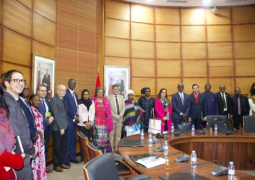
The Gambia Bureau of Statistics (GBoS) in collaboration with MoTIE and with support from development partners; UNDP, ILO, IOM, ITC, and EU has conducted the GLFS 2022-23 and obtained a comprehensive labour market data for evidence-based decision making.
In his opening statement, Minister Joof conveyed gratitude and appreciation on behalf of His Excellency Adama Barrow, President of the Republic of The Gambia, to partners particularly UNDP, ITC/YEP, GIZ-PME, ILO, and IOM for supporting the government to conduct this year’s national labor force survey. He expressed heartfelt gratitude to GBoS, particularly the enumerators, data analysts, and statisticians and everyone who made the day a possibility.
He added that the Labour Force Survey (LFS) data, generally provides a snap-shot of the labour market at a given point in time. As such, it serves as the primary source for monitoring global commitments to the world of work, and to Sustainable Goal 8 (Decent Work and Economic Growth) and Goal 5 (Gender Equality) of the 2030 Agenda for Sustainable Development.
“At the national level, the LFS enables government to better understand the dynamics of the labour market and thus enable her to make informed decisions that foster job creation, improve working conditions and the overall well-being of the workforce,” he stated, noting that the outcome of the survey will help to identify areas of the labour market where current government policies and programmes can be improved for inclusive and sustainable development.
The results, he said, will also be a recipe for strengthening collaboration with development partners and the private sector to increase investment in the productive and key sectors of the economy. This is with a view to increasing production and productivity, boost employment creation opportunities, and ultimately, reducing unemployment and poverty.
For her part, UNDP Resident Representative, Ms. Aissata De disclosed that the first and second Labour force surveys were conducted in 2014 and 2018 and the one being validated that day marked the third national labour survey report. She added that the UNDP supported the first two and partnered with other UN agencies such as ILO, ITC, and the Government of The Gambia in the current survey.
She said the LFS is a study of employment circumstances and provides the official measures of employment and unemployment. “It measures economic activity and inactivity, all aspects of people's work, job-search for the unemployed, education and training, income from work and benefits. The labour force, or the currently active population, comprises all people who fulfil the requirements for inclusion among the employed and well or the unemployed,” she stated. According to her, it is an internationally accepted measure of unemployment, and thus international comparisons are more valid as the definition is standardised.
Ajara Jallow, National Project Coordinator ILO expressed confidence that the information contained in The GLFS would be of great value to policy makers and other stakeholders in framing programmes of action to combat labour under utilisation, in particular youth unemployment, child labour among others. In this framework, she said, the ILO would like to encourage the Government, workers’ representatives, and employers’ representative to build a strategic alliance to formulate and implement a nationally owned programme to support decent work in The Gambia.
In welcoming the participants, Mr Nyakassi Sanyang, Statistician General at GBoS, stated that the main objective of the survey was to collect labour market information and other socio-economic data prepared for policy formulation and decision making.
Speaking earlier, the representative of International Trade Centre, Mr. Kebba Secka, congratulated GBoS and MoTIE for the successful completion of the 3rd comprehensive LFS for The Gambia.




